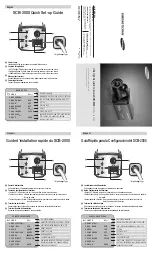
When the lens moves, the light rays from the subject are bent
relative to the optical axis, resulting in an unsteady image
because the light rays are deflected. By shifting the IS lens group
on a plane perpendicular to the optical axis to counter the degree
of image shake, the light rays reaching the image plane can be
steadied. Since image shake occurs in both horizontal and
vertical directions, two shake-detecting sensors for yaw and
pitch, detect the angle and speed of movement and send this
information to a high-speed 32-bit microcomputer, (which
converts the information into drive signals for the IS lens group).
Then, the actuator moves the IS lens group horizontally and
vertically, thus counteracting the image shake and maintaining a
stable picture. The Shift-IS component is located within the lens
groups and is most effective for lower frequency movements
caused by platform vibration or wind effect without increasing the
overall size and weight of the master lens.
How the Optical Image Stabilizer (Shift-IS) Works.
The history of field lenses is a history of zoom ratio/focal length
extension. It came to a point where the industry thought it would be
impossible to push the envelope any further. The telephoto focal
length of the lens became so long that even the slightest amount of
wind or operator movement would cause image shake and viewing
the picture became intolerable. This was before Canon announced
the incredible magnification of the DIGISUPER 86xs zoom lens.
Canon, renowned for its optical image stabilization technologies,
developed another new stabilization solution for the broadcast field
lens, a built-in Optical Shift Image Stabilizer (Shift-IS) to overcome
image shaking at telephoto focal lengths. Now, the Shift-IS is
employed in the following lenses:
DIGISUPER 100
AF
DIGISUPER 100xs
DIGISUPER 86
AF
DIGISUPER 86
II
xs
DIGISUPER 86
II
TELExs
DIGISUPER 75xs
HJ40x Series
Converter
Lens
Camera
Electronic
Conversion
Image Size Conversion
LO-32BMT
2/3" B4 Mount
1/2" SONY
approx. 1.4x
–––––
LCV-41E
2/3" B4 Mount SONY PMW-EX3 approx. 1.4x
Lens Cable
(12pin)
g
EX3
Hot Shoe(14pin)
LCV-40B
2/3" B4 Mount 1/2" Standard
Mount
approx. 1.4x
–––––
LCV-42T
2/3" B4 Mount 1/3" Standard
Mount
approx. 1.8x
–––––
Canon offers a variety of Mount Converters to be used between a
lens and a camera of different image format sizes. Each converter
will extend the effective angular field of view of the associated lens
according to the Shift Ratio listed below
*1 SONY's Hot Shoe mount camera, excluding PMW-EX3
*2 1/2" Camera of standard type mount (Panasonic, JVC, Ikegami)
*3 Only applicaple to KH10ex/KH16ex/KH21ex
The other 1/2" mount lenses are not available
Note: The converters are to be used with lenses weighing less then 2.0kg (4.4lbs)
LCV-20E
1/2"
SONY PMW-EX3
–––––
Lens Cable
(12pin)
g
EX3
Hot Shoe(14pin)
LO-32BMT
LCV-40B
LCV-42T
LCV-41E
LCV-20E
Shift Ratio to
Telephoto Side
*3
*2
*1
External Extender Control Unit
RE:
motorized 2X extender
ME:
manual 2X extender
Remote Control Accessories
(not available for HJ18ex / HJ14ex)
Four types (82CL-UP800H / 82CL-UP1300H / 105CL-UP900H /
105CL-UP800HD) are available.
Remote Controller
Several models are available.
*The controllers are also applicable to remote control
pro-video lenses.
Connecting Cable
5m, 10m, 20m, 50m and 100m cables are available.
Maximum cable length is 150m by connection of these cables.
Mount Converters for Different Image
Format Size Cameras
Optical Shift Image Stabilizer
(Shift-IS) Technology
38
39



































